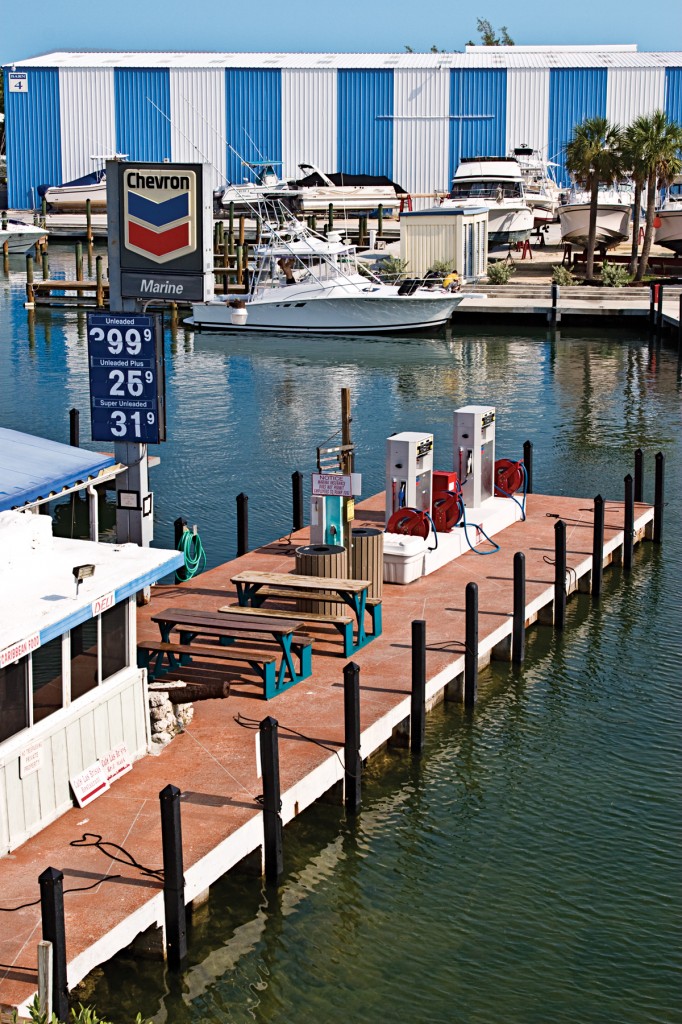January 06, 2016
By Al Herum
Tips to save at the gas dock.
 Hard-to-figure prices, empty fuel docks. How do we cut fuel costs?
Hard-to-figure prices, empty fuel docks. How do we cut fuel costs?
With marina gas prices topping $4 a gallon in some parts of the state you can save serious bucks by getting top performance from your boat. Here are five tips to help you eke out every last mile from each drop of gas in your boat's fuel tank.
1. Prop your boat right. You should have a propeller that gives optimum overall performance, not simply the best top speed. Make sure your engine revs toward the high end of its maximum rpm range at full throttle, especially if you're doing test runs with a light load. Pick a prop that provides your boat with a good hole shot and gets it on plane quickly. Lugging along with the bow pointing toward the heavens struggling to get on plane is not only unsafe, it burns lots of gas. Finally, don't worry if you aren't getting the absolute maximum speed claimed by the boat maker. They strive for big numbers because it sells boats. You should strive for maximum efficiency because it saves you dollars at the pump.
2. Don't carry extra weight aboard. That means you shouldn't carry 200 gallons of fuel when you know you're only going a few miles to anchor down and fish the bottom. But do carry sufficient fuel for your planned trip plus an extra 20 percent in reserve. Don't carry hundreds of pounds of ice if you are only planning to keep a few fillets for dinner. Only fill your water tank with enough water for the planned trip. A 5-gallon bucket dunked from over the side gets blood and chum off just as well as a freshwater hose. Livewell water should be considered here too—if you are going to use it, fill it; if not, don't.
On occasion you should go through all the gear you have stored aboard and decide if you really need it. Extra stuff has a way of finding a home in the bottom of boat storage compartments and slowly but surely adding pounds to your craft.
3. Load your boat properly. That means distribute whatever movable weight—including people, fish, ice, food and drinks—you are going to carry evenly around the boat. Make sure to load up so your vessel is not heavy in the stern, bow or on one side. Extra stern weight will affect the minimum planing speed of your boat. Too much weight in the rear will make it hard to stay on plane at low speeds. This can be a huge issue in rough seas where a slow speed is needed for safe and comfortable passage. If you're able to stay on plane you'll save a ton of gas compared to plowing along bow-high off plane. Too much weight in the bow can cause it to dig into the sea creating unnecessary drag. Uneven side-to-side weight will require you to use trim tabs (if you've got 'em) to center the load. This adds to water drag and causes extra fuel to be burned.
4. Keep your hull clean. A smooth boat bottom is about the most drag-free configuration you're going to get. So make sure you keep it that way by washing it after use and making sure it is grass- and slime-free after any extended time in the water. If your boat has bottom paint and stays in the water continuously you should have a diver go down at least every three months and brush off any areas of soft growth from the bottom and running gear. In addition, every two years or so you should have the bottom pressure-washed, prepped, and repainted as needed. Most modern-day bottom paints can easily keep hard growth at bay for a couple of years without repainting. On older boats it is wise to check that everything hanging off the bottom of your boat has a use. Old inoperative thru-hull transducers and the like can add significant water drag, decrease speed, and increase fuel consumption.
5. Operate your boat in an efficient manner. Don't be a throttle-jockey. These guys slam the throttle wide open every time they take off and keep it on the pin while they dance across the waves. This may sound fun but it surely is an expensive way to travel. More appropriate throttle usage would be to get the boat moving at a fast idle speed, then push the throttle to about three-quarter position to get on plane. Once you're on the step and accelerating start bringing the throttle back immediately. Pick a cruising speed that is suitable for the conditions and stay at it by leaving the throttle set in that position. If the sea conditions are not a factor in your speed selection, use your boat's most efficient planing speed. This is frequently around 75 percent of your top rpm.
Follow these simple tips and you'll see a lot more fuel left in your tanks at the end of the day. That either means more money in your wallet, or an extra trip without visiting the pumps; both are good things.

